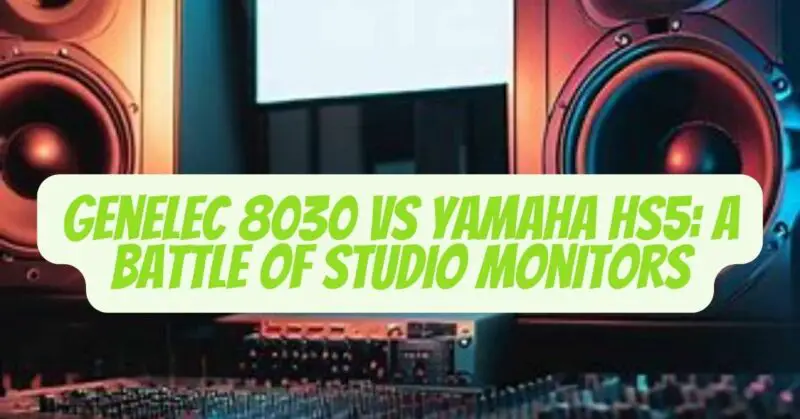When it comes to studio monitors, two brands that have gained a reputation for their exceptional quality are Genelec and Yamaha. In this article, we will delve into the comparison of two popular models: the Genelec 8030 and the Yamaha HS5. These studio monitors are often sought after by both professional audio engineers and home studio enthusiasts alike. By examining their specifications, features, and performance, we aim to help you make an informed decision and choose the monitor that best suits your needs.
Specifications and Features
The Genelec 8030 and the Yamaha HS5 are both compact studio monitors designed for near-field monitoring. They are known for their accuracy, clarity, and reliability. Let’s start by looking at their specifications.
The Genelec 8030 features a bi-amplified design with a 5-inch woofer and a 3/4-inch tweeter. It has a frequency response of 58Hz to 20kHz and a maximum SPL of 100dB. The monitor boasts a unique Minimum Diffraction Enclosure (MDE) design, which minimizes cabinet edge diffraction and delivers precise imaging. Additionally, it includes Genelec’s Intelligent Signal Sensing (ISS) technology that automatically adjusts the power consumption according to the audio input signal.
On the other hand, the Yamaha HS5 offers a 5-inch woofer and a 1-inch dome tweeter. It has a frequency response of 54Hz to 30kHz and a maximum SPL of 102dB. The HS5 incorporates Yamaha’s advanced noise reduction technology, which helps to minimize unwanted artifacts and ensure accurate sound reproduction. It also features room control and high trim response controls, allowing for customization according to the acoustic environment.
Performance
Both the Genelec 8030 and the Yamaha HS5 deliver exceptional audio performance, but there are slight differences worth considering.
The Genelec 8030 is renowned for its neutral and transparent sound reproduction. Its extended frequency range ensures precise detail across the entire audio spectrum, making it suitable for critical listening and professional applications. The MDE enclosure design minimizes cabinet resonances, resulting in accurate imaging and enhanced stereo separation. The ISS technology not only saves energy but also provides instant response, ensuring optimal performance at all times.
The Yamaha HS5, on the other hand, has a slightly wider frequency response, offering a more extended low-end compared to the Genelec 8030. It delivers a balanced sound with a smooth midrange and clear highs. The advanced noise reduction technology reduces any unwanted resonances or coloration, resulting in a more accurate representation of the audio source. The room control and high trim response controls allow users to tailor the monitor’s sound to compensate for acoustic deficiencies in the listening environment.
Both monitors excel in terms of accuracy, but personal preference and the nature of the audio work might sway your decision. The Genelec 8030 leans towards precision and analytical listening, ideal for professional studios where every detail matters. The Yamaha HS5, with its slightly more pronounced low-end response, may be preferred by those who work with bass-heavy genres or enjoy a warmer sound signature.
Conclusion
In the battle of Genelec 8030 vs. Yamaha HS5, both studio monitors offer outstanding performance and reliability. The Genelec 8030 stands out with its exceptional accuracy, neutral sound reproduction, and intelligent features such as the MDE enclosure and ISS technology. It is a perfect choice for professionals who demand the utmost precision in their audio monitoring.
The Yamaha HS5, on the other hand, offers a balanced sound with extended low-end response, making it suitable for various music genres and home studios. Its advanced noise reduction technology and customizable controls provide flexibility and adaptability in different acoustic environments.
Ultimately, the choice between the Genelec 8030 and the Yamaha HS5 comes down to personal preference and specific requirements. If you prioritize precise and analytical sound reproduction, along with intelligent features, the Genelec 8030 would be an excellent investment. On the other hand, if you prefer a balanced sound with a slightly emphasized low-end response and customizable controls, the Yamaha HS5 could be the ideal choice.
It is worth noting that both monitors have received positive reviews from users and professionals in the audio industry. The decision should be based on careful consideration of your specific needs, the type of music you work with, and the listening environment in which the monitors will be used.
In conclusion, the Genelec 8030 and Yamaha HS5 are both exceptional studio monitors that offer high-quality sound reproduction and reliability. Whether you prioritize accuracy and precision or a balanced sound with customization options, both monitors have their unique strengths. Whichever model you choose, rest assured that you will be investing in a trusted brand known for its commitment to delivering exceptional audio monitoring solutions.
Remember to audition the monitors whenever possible, as personal listening experiences can greatly influence the decision-making process. Ultimately, the Genelec 8030 and Yamaha HS5 have proven their worth in professional studios and home recording setups, offering reliable tools to help you achieve the best possible audio production results.


